Dolphin 文件管理
Dolphin or Konqueror?
Dolphin is the file management application of Plasma Workspace. It is designed to be simple to use, yet powerful.
Konqueror was the default file manager in KDE 2 and 3, and is still available for those who prefer its interface. It is a web browser, a file manager, media viewer and more. For file management it uses the Dolphin KPart, and so has all of the functionality of Dolphin.
发掘 Dolphin
第一部分将带您预览 Dolphin。第二部分涉及不同类型的书签的概念。第三部分讨论文件管理。最后,我们来看'更酷的东西'。可以点击图片查看大图。
介绍 Dolphin
Dolphin 是 KDE 软件集(Software Compilation)的文件管理器。
我会展示如何用 Dolphin' 完成一般的文件管理任务和定制它满足你的需要。
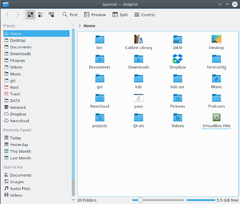
当我们从Kickoff菜单里打开 Dolphin,他首先显示的是开始目录- 通常是 主文件夹。
To open a file, or go to a folder just click on it. (This can be changed to double-click in → → or in → → for older versions of System Settings)
要选择和取消选择文件/文件夹,悬停鼠标指针到图标上,点击出现的+号来选择,点-号来取消选择。像是这样:
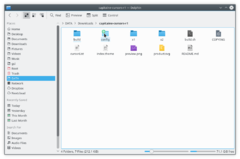
当你点击+号,文件/文件夹就会被选中。你可以用这种方法选定多个文件(鼠标拖拽矩形选择文件也是有效的)。你也可以用Ctrl + 单击一次一个的选定/取消选定,Shift + 单击来连续操作。
多个被选中的文件看起来是这样的:

Creating a new folder: You can create a new folder in the active directory using → or the F10 shortcut.
Tabs: Dolphin supports tabbed browsing. A new tab can be opened for example from → (if you have enabled menu bar), by Ctrl + T or by middle mouse click on folder icon and navigation buttons.
点击如何文件夹的时候都会默认启动 Dolphin。也能在 Kickoff 菜单里启动它.
The Interface
Location Bar
Dolphin integrates a new concept to use the location bar in a faster and more precise way: therefore a breadcrumb location bar is used. Instead of displaying the complete path only the navigation points starting from one of the places are displayed as buttons. By clicking one of these buttons you navigate directly to this folder. In this way you can reach a parent folder from a sub folder in a very quick way.
在代表文件夹的按钮之间有一个小的箭头也是个可点击的按钮。点击这个箭头你能看到一份列表,列表里是跟你现在这个目录同级的所有子目录(译者注:这说的是你点当前这个文件夹按钮前的「箭头」的情况,其实列表显示的就是「箭头」前那个文件夹的所有子文件夹),使你能快速改变目录。
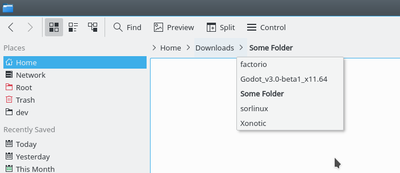
There is also a classical location bar which displays the complete path. To use this style you can right click on the Location Bar and select . If you want the Location bar to become editable, trigger the keyboard shortcut Ctrl + L or select → → . By clicking on the free space next to the last displayed folder in the breadcrumb style you can switch to an editable Location Bar as well. If the editable style is selected a checkmark is displayed at the end of the location bar. This checkmark is a button which can be used to change back to the breadcrumb style. Of course menu and keyboard shortcut can be used, too.
Split View
Dolphin offers the possibility to split the current folder view so that two folder views are displayed next to each other as known from Midnight Commander, or Krusader. This is a very comfortable view to copy or move files from one folder to another.
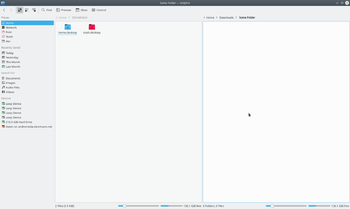
You can split the view by clicking on in the tool bar or, if you have enabled menu bar, (keyboard shortcut F3). To change back to only one folder view you can click on or just press F3 again. The symbol will show you which view will be closed. Depending on the currently active view the minus sign will be shown in the left or right part of the symbol. The active view will be closed. This is important to know if you want to use the keyboard shortcut. There is also a button for splitting and closing the view situated in the toolbar. This button displays the minus symbol as well, so it is easy to know which view would be closed.
Of course each view has its own location bar and each view can use a different view mode.
Sorting Files
By default, the files in the currently displayed folder are sorted in ascending alphabetical order. However, this can be changed by selecting → .
Files may be sorted by the following attributes
- Name
- Size
- Date
- Permissions
- Owner
- Group
- Type
- Link Destination
- Path
The sorting method can be changed by selecting → → , → → or → → .
View Mode
Dolphin features three different folder view modes:
 Icons shows each file or folder as an icon with its name
Icons shows each file or folder as an icon with its name
 Compact is the same as icons, but in a more compact form, allowing more folders and files to be displayed at once
Compact is the same as icons, but in a more compact form, allowing more folders and files to be displayed at once
 Details presents a list of files and folders, giving information on each, including but not limited to size and date
Details presents a list of files and folders, giving information on each, including but not limited to size and date
The mode can be changed from within Dolphin
- Select from the menu. This option is only available if the main Menubar is enabled
- Select from the menu. This option is only available when the main Menubar is disabled
- By selecting the appropriate icon from the main toolbar, if it is enabled
- Using the default keyboard shortcuts:
- Ctrl+1 switches to the Icon display mode,
- Ctrl+2 switches to Compact and,
- Ctrl+3 switches to Detailed view.
View as Icons
Each file and each folder is represented by an icon in this mode. Alternatively a preview, or of the file can be displayed. Instead of displaying an icon a preview of the file can be shown. This feature can be turned on/off via the menu → (if menu bar is enabled) or via the main toolbar button .
There is the possibility to display additional information below the icons. These can be turned on/off via → or → (if menu bar is enabled). In principal the same criteria which are available as search criteria can be selected.
You can group the icons to achieve a better overview. This is turned on via → or → (if menu bar is enabled). Now the icons are grouped and the groups are divided by a horizontal line containing the name of the group as caption. The grouping is related to the selected search criteria.
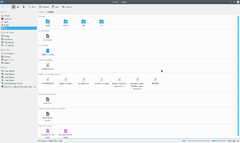
细节
"细节"视图模式下对比"图标"视图模式默认会显示许多额外的信息。所有文件都列在一个表格内。表头的关联菜单能够添加额外的列。可用的列如下:
- 大小
- 日期
- 权限
- 拥有者
- 群组
- 类型
- Link Destination
- Path
分列 "名称" 总是显示的。点击每个分列的顶部,列表会根据这个分列重新排序。点击分列顶部,分类序列会复原(译者注:靠(#‵′) 为什么我这不会恢复,只会反向再排序一次)。
Since KDE 4.1 it is possible to display the folders as a tree. In this mode a plus sign is shown next to the folder. Plus sign has been replaced by > symbol in newer KDE versions. By clicking on this sign the folder is expanded and all containing sub folders and files are also shown in the table but they are attenuated. By clicking the sign, which displays a minus now (or an arrow pointing downwards in latest versions), again the expansion is closed again. Of course the tree structure can be used for as many folders as wished. In latest KDE releases, the tree view is enabled by default, but can be deactivated via → → → with option .
分列
View mode "Columns" was inspired by the file manager Finder of Mac OS X. Entering a sub folder did not replace the current folder view but the content of the sub folder was listed in an additional column next to the column of the parent folder. This could be used for several hierarchies, so that you could navigate in an easy and fast way in the file system. Since KDE 4.8, view mode "Columns" has been dropped and will not be available in future Dolphin releases.
Setting defaults for all folders
Under → (or under the menu item → if you have enabled menu bar) you can set any of these attributes to be the default for all folder views.
面板
Dolphin contains several panels, which can be activated via menu → . Each panel can be placed in the left or right docking area. To move a panel you have to unlock panels (right clik on a panel and select ), click on the header and Drag&Drop the panel. The area where the panel will be placed on mouse released is highlighted. It is possible to stack panels on top of each other. In this case the panels are placed into tabs.
在每个面板的标题有两个按钮。接近标题的按钮可以游离(undock)面板。这使得面板成为一个独立的窗口「漂浮」于 Dolphin上。但窗口还是与 Dolphin结合的,不能在没有 Dolphin时显示,不能像普通窗口一样最小化。再次点击按钮,面板可以回复停靠。第二个按钮会关闭面板。
非模态窗口(Non Modal Dialogs)
当移动,复制或删除文件/目录,这个对话框甚至会在操作还没完成的时就消失不见。然后一个进度条便出现在屏幕右下角,之后也会消失,如果你想要查看进度你需要点击系统托盘里的一个小的「i」信息图标。
地址
Dolphin contains a new kind of bookmarks Places. These are displayed in a panel which can be activated via → → (keyboard shortcut F9). The default Places are identical to the ones shown in the category Computer of the K-Menu Kickoff.
点击地址中一个,他就会在当前文件夹视图内打开。右键关联菜单能够编辑「地址」或再次删除它们。同样能临时隐藏个别的条目。
文件夹的关联菜单能用来添加这个文件夹作为一个条目到「地址」面板,有个菜单项是。你也能拖放一个文件夹到「地址」面板。
地址面板也包含了链接到可移动设备比如USB-keys或CD的条目。如果设备被挂载会显示一个小的「插头图标指示」。关联菜单能够卸载这个设备。
「地址」被使用作为「面包屑导航栏」中的基础,导航栏中显示的地址,起点就是「地址」中与其有关的最近的父文件夹。
信息
The information panel can be activated via → → (keyboard shortcut F11). This panel displays a preview or an icon of the currently selected file/folder or of the file/folder below the mouse cursor. Some additional information like change date or size to the file/folder is displayed as well.
信息面板提供了给文件评星级,添加注释或标记文件的可能性。这是为桌面提供语义网络特性的语义桌面Nepomuk的一种界面。自KDE 4.2后,可以通过搜索「标记」(tags)搜索语义链接。现在的「标记」(tags)仅给了对未来版本的一个展望。
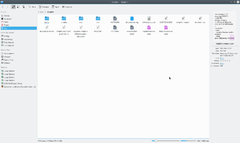
文件夹
A panel providing a tree structure for the file system can be displayed via → → (keyboard shortcut F7). The tree structure offers the possibility by clicking the > and ˇ signs to expand/collapse sub folders. By clicking on one of the folders the content will be displayed in the current view.
终端
The terminal emulator Konsole can be displayed directly in Dolphin via → → (keyboard shortcut F4). This makes it possible to use shell commands directly in Dolphin. The terminal is opened in the folder which is displayed in the current view. Shift + F4 opens Konsole in new window.
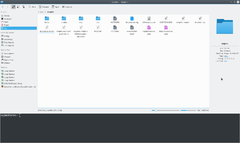
文件系统导航
书签和地址
KDE3下你能在 Konqueror 里创建书签,但是他们对其他任何程序都没用。KDE SC 4.x 有着长足的进步变得更灵活了 - 但也不可避免的更复杂了。实际上KDE SC 4有三种类型的'书签',需要区别开来。他们属于不同的文件,各有不同的功能。
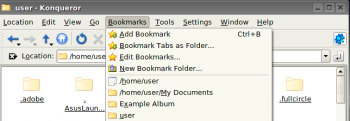
三种类型的书签
First, there is the set of bookmarks available only to Konqueror - web bookmarks. These are stored in ~/.local/share/konqueror/bookmarks.xml. Then there is a set which Dolphin calls Places. This set is available to all applications as well as the Dolphin file manager. Every time you use → you will see this set. The third set of bookmarks are Application Bookmarks. These share one file, regardless of the application that set them, and are available to all applications, unless you restrain them to a specific application. More of that later.
启用书签
Bookmarks are not enabled in dialogs by default. To enable them
- Open the menu and select or
- Click the Options
 icon
icon - Select
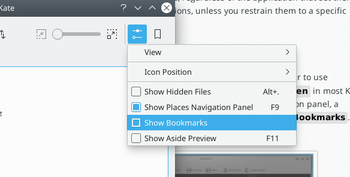
"地址"-全系统的导航
这里是一组默认的 地址项 -
- 主文件夹
- 网络
- 根
- 回收站
但你能添加其他地址。在 Dolphin 里,右击一个文件夹并选择。
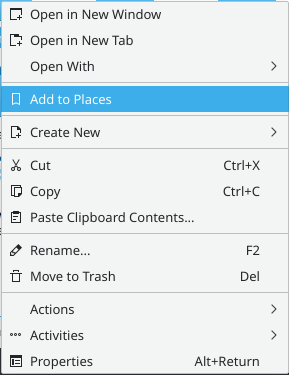
默认"地址"就在所有程序里可见。如果你想要让他限制在 Dolphin 内,你需要右击地址列表里的新名称,那你会找到编辑他的选项。有个复选框。
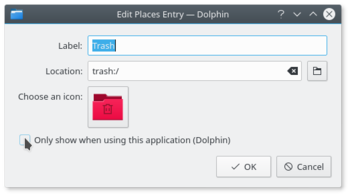
You can see the result of that command if you read ~/.local/share/apps/kfileplaces/bookmarks.xml.
In some applications too there is an option in the File menu to add a folder to Places. At this stage, however, applications vary in which features are available. The important thing to remember is that the default is for Places items to be available to all applications in the → dialogue.
程序中的书签
This is the second class of bookmarks. Remember opening → and using the spanner/wrench? Next to it is a yellow star. This is the bookmark management menu.
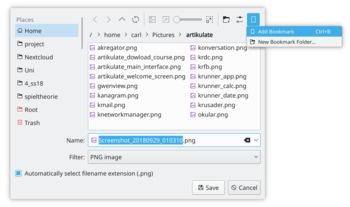
Here you can define bookmarks that will be visible in the same menu on any application. They are stored in one file, ~/.local/share/kfile/bookmarks.xml, which is used by all applications having that menu.
限制在某个程序内
一些程序允许你编辑地址菜单中的项目。例如,如果在Gwenview,你右击地址中的文件夹,你可以设置选项成。
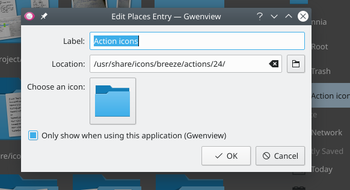
If you need to constrain to an application that does not yet allow you to do that, the only way left is to edit the file ~/.local/share/kfile/bookmarks.xml. Immediately before the </metadata> tag you will need to add the line
<OnlyInApp>appname</OnlyInApp>
Dolphin 的压缩管理
现在管理压缩很容易的。 Dolphin里任何的目录下,选择高亮你想要压缩的文件,右击。然后用压缩选项,你能创建RAR压缩包,Gzipper tar压缩包,或是定义另一个你建立好的压缩模式。
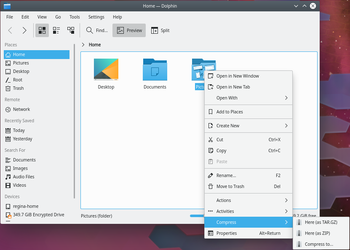
类似的,如果你右击一个现有的压缩文件,你会看到添加在右击菜单里的一系列动作。你能解压这个压缩包的内容到当前文件夹,到自动判定的子文件夹或是到另一个你选择的地方。
若你要添加文件到现有的压缩包,你可以选择。
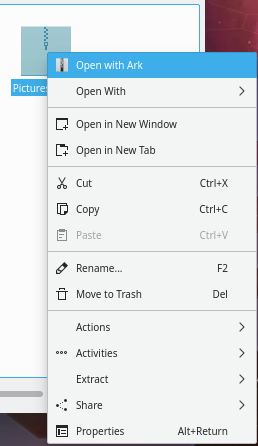
更多酷的操作
Change a File Association on-the-fly
Have you ever wanted to open a file, only to find that it is associated with an application that is not of your choice?
You can, for one, alter this in → → → → . This is the same as running kcmshell5 filetypes in a Konsole.
Alternatively, if you want to change multiple associations right quick, you would edit the *.desktop file directly, e.g. the file /usr/share/applications/org.gnome.Builder.desktop. For example, Gnome Builder associates with a great number of file-types which may not be desirable. So the line
MimeType=application/javascript; # we do not want all of these ....
may be shortened or commented out with # . Maybe a line
InitialPreference=2 X-KDE-InitialPreference=3
in the builder.desktop file helps to keep your previous default associated app, with builder being only secondary or tertiary option.
Thirdly, Dolphin and Konqueror offer a quick method for changing a single association:
Right-click on the file and select . The first line there is descriptive, something like:
Type: XML document
在同级,右侧,有个「扳手」图标。点击图标,你可以添加或改变一个关联。
类似的,对于文件夹,你可以修改默认的文件管理器为(或非)Konqueror,你也可以选择,或添加另一个图片浏览器为可用的关联。
动作子菜单
The sub-menu opens up a whole lot more cool things to do from Dolphin. Some possibilities only appear when applicable to the file you have selected. An apps .desktop file below /usr/share/applications defines what actions are applicable for a particular type of file. Some of the options are
- Convert an image file to a different format
- Preview the file
- Download a remote file with KGet
- Sign and/or encrypt the file, according to the encryption software installed
转录和拷贝音频CD音轨
- 插入音频 CD
- Dolphin 里进入这张 CD:他必定会作为「标卷」的形式出现在你的 Dolphin「地址」里或你能在地址栏上输入 audiocd:/ 进入。
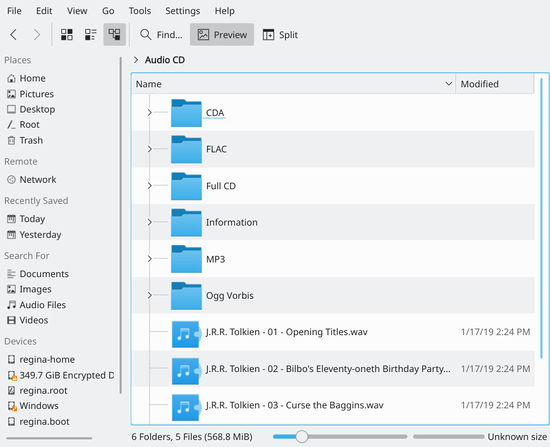
现在你注意到 Dolphin提供每个音轨的 WAV 文件外,再加上:
- CDA 文件夹,以常见的CDA格式保存了索引信息。
- 整张 CD 的文件夹,将全部音轨以每种格式(.cda,.flac,.mp3,.ogg,.wav)各保存一份文件,各个文件格式不同,但都覆盖了全部音轨。
- FLAC 文件夹,包含了翻录成FLAC格式(无损信息格式)的音轨
- 包含了 CDDB 信息的 Information 文件夹
- MP3 文件夹,包含了以 MP3 格式存储的所有音轨
- Ogg 文件夹,包含了翻录成 OGG 格式的音轨。
然后你仅仅只需要复制喜欢的格式的那个文件夹,就获得你那张CD对应的转录版本!
timeline:/ and have your recent files as startup folder
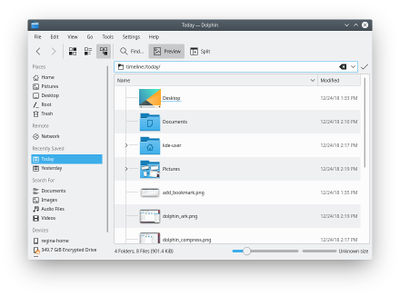
In a current (2017, Version 16.08.3 of) dolphin (with baloo up and running), you can start up dolphin with a view of recently modified files: Just navigate to the address/location of timeline:/today/ (copy paste it to the address bar) or use it as dolphin start-up-folder in dolphin-settings. With older versions of dolphin, this required the below manual steps:
Dolphin has access to a large number of file transfer protocols (KIO Slaves). One of those is provided by the KDE semantic search system (Nepomuk). Nepomuk offers a transfer protocol named history. You can navigate to it by entering timeline:/ in the location bar.
One particularly neat thing there is the ability to have the Today folder from the timeline:/ protocol in the Places sidebar (you can just drag it there!). You can then change the name and icon (do a right click on the new Today entry and choose ).
It could be very useful to have this view of recently used files immediately when you start Dolphin. Unfortunately, as of Dolphin 2.1 (part of KDE SC 4.9) this is not possible without editing the Dolphin configuration file. See this blog for more details on that.
To edit the configuration file, first close all Dolphin windows. Dolphin will save its configuration upon closing, overwriting any changes you might make!
Then use KRunner (Alt + F2) to edit ~/.config/dolphinrc with KWrite as follows: kwrite ~/.config/dolphinrc. You can of course use any other editor as well, like Kate. In the configuration file, locate the [General] section to edit the HomeUrl into: HomeUrl=timeline:/today and save the file. You should now have the today view as default and have the files you're most often looking for at your fingertips!



